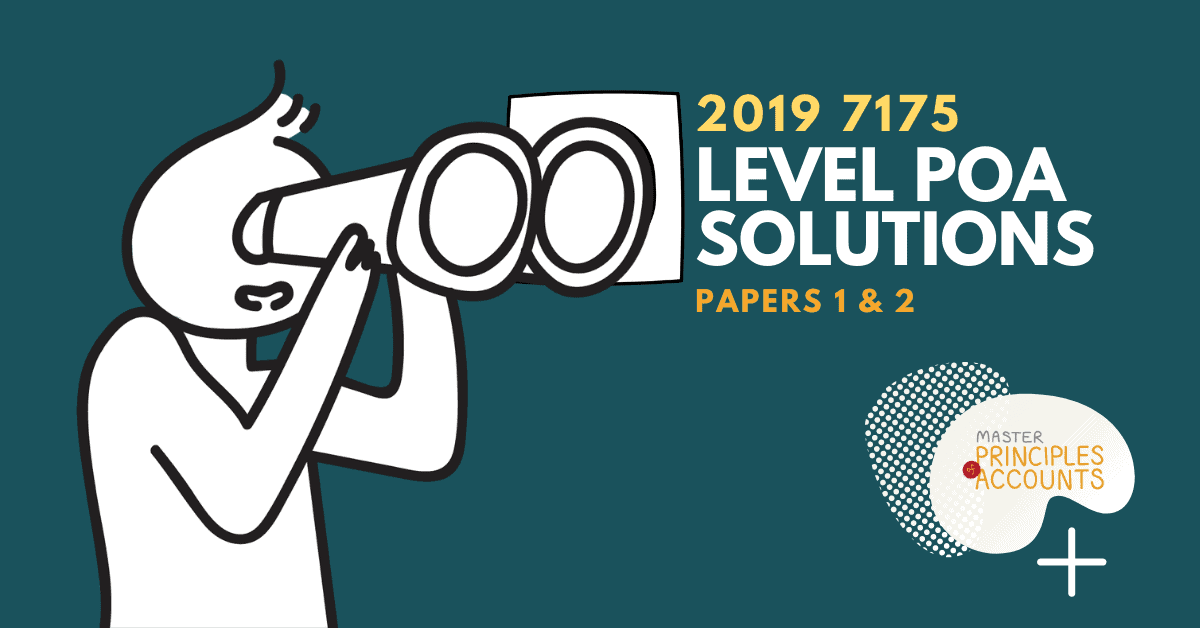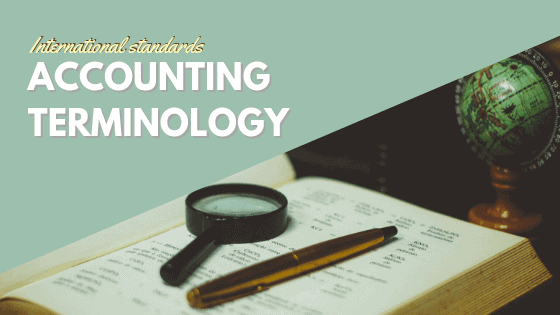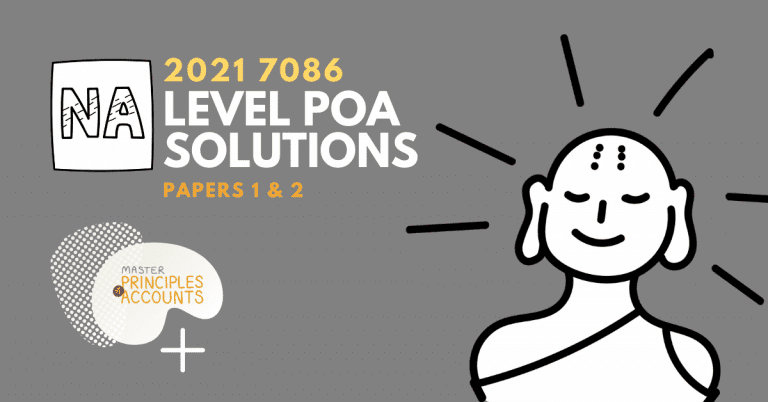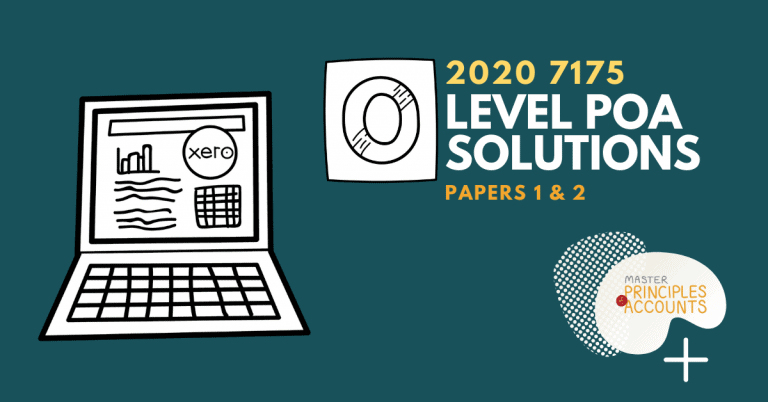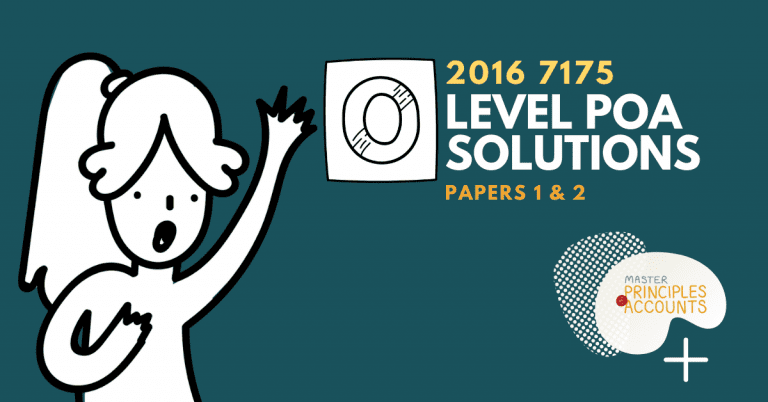2019 7175 GCE O Level POA Paper 2 Solutions
Hey folks!
Just done up the 2019 GCE O Level Paper 2 Solutions.
Let me know what you think in the comments below!
As predicted in our GCE O Level Webinar last night, these specific chapters came out for Paper 2:
- Prepayment and accruals
- Profitability ratios
- Issued share capital
- Trade payable subsidiary ledger
If you are keen to join in for the weekend classes tomorrow and sunday, drop me a Whatsapp at 92337246
Paper 1 :
a) Inventory which are purchased first assumed to be sold first.
b) Basis of valuating inventory :
i) Either
– the lower of cost and net realisable value; or
– Inventory should be valued at cost or net realisable value, whichever is lower
ii) Concept : Prudence concept
c) W1 – $375- $50
W2 – $12,220 – ($400-$325) = $12,125 (4m)
d) i) Gross profit: No effect
ii) Profit for the year: Overstated by $75 ($400-$325)
iii) Current assets at 31 March 2019: Overstated by $75 ($400-$325) – Total 13 marks
a) Working capital is derived from taking current assets less current liabilities
b) 2 reasons for working capital
i) To pay for day-to-day operating expense
ii) To pay for short term debts when they fall due
c) The difference between the current and quick ratios is that the current ratios includes prepayments and inventory while the quick ratio includes only quick assets such as cash in hand, cash at bank and receivables.
d) $19,879/ ($3250 + $24500 + $3700) = 0.63
e) Current ratio of the business has worsened from 2.63 in 2017 to 1.96 in 2019 , which is above the general benchmark of 2, in 2015 to 1.95, which is below the general benchmark, in 2016.
The more stringent test of liquidity, quick ratio, also worsened from 1.78 in 2017 which is above the general benchmark of 1 to 0.63, which is below the general benchmark of 1, in 2019. This indicates that the business does not have sufficient quick assets to repay its current liabilities/ cashflow difficulties.
f) 1. The decline in liquidity was also in part due to the business locking up funds in the form of inventory, where inventory made up to 64.0% of total current assets.
2. If suppliers are unable to collect from Nashua in a timely manner, they may stop supplying to Nashua on credit. This will exacerbate the already strained liquidity position and may even the availability of goods for resale.
a)
| Bank Loan | Bank overdraft | |
| 1.Cash transference | Cash is transferred from the bank to the business upon acceptance of loan. | Cash is not transferred to the business. The business withdrew more than the available balance in the bank. |
| 2. Amount borrowed | The amount is agreed before the loan is granted thus it is a fixed amount. | The amount borrowed is not fixed however is limited. The amount borrowed must not exceed the maximum overdraft facility offered by the bank. |
| 3. Repayment period | The loan is repayable over its term which usually spans over more than a year. | The amount is repayable within a few months or days from the withdrawal. |
| 4. Payment method | Loan is repayable over its loan term in fixed cash repayments. (Example monthly repayment) | No fixed cash payment is required. Any deposits into the bank account will reduce the outstanding balance. |
| 5. Reporting | Non-current liability. The current portion (payable within a year) is under current liability | Current liability. Spans over less than a year. |
| 6. Interest expense | Subject to interest based on loan amount. | Subject to interest if overdraft facility is used more than the agreed period. Example: 3 months overdraft allowed however overdraft goes on for 4 months. The one extra month would be subjected to interest. |
b) – Bankers
– Other lenders
Reason:
To see the credit worthiness of the business.
c)
| Date | Particulars | Dr | Cr |
| 2017 | |||
| Oct 1 | Cash at bank | 150000 | |
| Long term borrowings | 150000 | ||
| 2018 | |||
| Sept 30 | Long term borrowing/ Current portion of Long term borrowing Cash at bank | 30000 | 30000 |
d) 6/12 x 150000 x 5% + 6/12 x 120000 x 5% = $6750
e)
| Statement of financial position as at 31 March 2018 (extract) | ||
| $ | $ | |
| Non-current Liabilities | ||
| Long term borrowings | 120,000 | |
| Current liabilities | ||
| Current portion of long term borrowings | 30,000 | |
| Interest expense payable ($120000 x 5% x 6/12) | 3,000 |
Paper 2 :
Ziqian
Statement of financial performance for the year ended 30 April 2019
| $ | $ | |
| Sales revenue (147,215 + 2,000) | 149,215 | |
| Less: sales returns | 1280 | |
| Net sales revenue | 147,935 | |
| Less : cost of sales | 99,720 | |
| Gross profit | 48,125 | |
| Add : other income | ||
| Commission income (5,470+ 250) | 5,720 | |
| Discount received | 450 | |
| 6,170 | ||
| Less : expenses | ||
| Rental expense (12/18 x 14,400) | 9600 | |
| Wages and salaries (23,000 + 1,250) | 24,250 | |
| Motor van expenses (3,610-1,500) | 2,110 | |
| General expense | 3,100 | |
| Discount allowed | 285 | |
| Depreciation on motor vehicle (20% x [62,000-22,320]) | 7,936 | |
| Impairment loss on trade receivables (545-340) | 205 | |
| 47,486 | ||
| Profit for the year | 6,899 |
Ziqian
Statement of financial position as at 30 April 2019
| Assets | $ | $ | $ |
| Non-current asset | cost | Acc. dep. | N.B.V |
| Motor vehicle | 62,000 | 30,256 | 31,744 |
| Office equipment | 350 | 350 | |
| 32,094 | |||
| Current assets | |||
| Inventory | 15,290 | ||
| Less: allowance for impairment of trade receivables | 545 | ||
| Net trade receivables | 14,745 | ||
| Commission receivable | 250 | ||
| Prepaid rent expense | 4800 | ||
| Cash at bank | 5041 | ||
| Total current assets | 35081 | ||
| Total assets | 61,175 | ||
| Equity and liabilities | |||
| Owner’s equity | |||
| Capital, 1 May 2018 | 57,911 | ||
| Add: profit for the year | 6,899 | ||
| Less : drawings (7,550 + 1,500) | 9,050 | ||
| Total equity | 55,760 | ||
| Current liabilities | |||
| Trade payable | 9,815 | ||
| Accrued wages and salaries expense | 1,250 | ||
| Other payable | 350 | ||
| Total current liabilities | 11,415 | ||
| Total equity and liabilities | 67,175 |
(a) business. Ownership of company that is issued to shareholders to raise capital for the
(b) Advantages of a company:
Investment and returns-Shareholders’ losses are capped at the amount invested.
Ability to raise funds-Banks are more willing to lend a business. It is easier to
raise capital via the issuance of shares.
Transfer of ownership-Easy of transfer. Shares can be transferred easily on
the consent of all partners.
(c) Stewardship: A steward does not own but is given the responsibility to manage the business:
The accounting information system provides the owner with information on how the business
(d)
Issued share capital
| Date | Particulars | Dr | Cr | Bal |
| 2018 | $ | $ | $ | |
| Apr 1 | Balance b/d | 195,000 Cr | ||
| 2019 | ||||
| Mar 31 | Cash at bank (50000 shares x $1.30) | 65,000 | 260,000 Cr | |
| Apr 1 | Balance b/d | 260,000 Cr |
(e)
Journal
| Date | Particulars | Dr | Cr |
| 2021 | $ | $ | |
| Retained earnings | 85,800 | ||
| Profit and loss | 85,800 |
Being the transfer of loss for the year to the retained earning account
(a)(i)
31 July 2018 31 July 2019
| Net sales revenue Cost of sales = Gross profit | ||
| Net sales revenue | Gross profit margin = 21%.Therefore, gross profit is 21%and net sales revenue is 100% 87150/21*100 = $415.000 | Gross profit margin = 18.5%.Therefore, gross profit is 18.5%and net sales revenue is 100%97125/18.5*100 = $525,000 |
(ii)
| Gross profit margin • % expenses to net sales revenue = Profit margin | ||
| Expenses | Expenses = 21%-12% = 9%9% $415,000 = $37,350 | Expenses = 18.5%-7.5% = 11%11% $525,000 = $57,750 |
(b)
The gross profit is on a downward trend. The gross profit margin has worsen from 21% in
2018 to 18.5% in 2019.
The decreasing trend is likely due to the changing of suppliers many times within the year.
Fatin may not have been able to suggests that the cost of sales has increased
due to a new supplier.
This IS supported by the increase in NSR from 415000 in 2018 to 525000 in 2019
The profit margin has worsen from 12% in 2018 to 7.5% in 2019.
Correspondingly, the percentage of expenses to turnover has increased from 9% in 2018
to 11% in 2019.
This is likely due to the increased rental cost from the expansion as well as the increase in
advertising and promotions undertaken to drive up the sales revenue.
Another reason for the decrease in profitabilitiy is due to the increased amount of
additional staff costs to provide personal services
Overall, even though there is higher gross profit in 2019 at $97125 as compared to
the gross profit in 2018 at $87150,
the profit for the year for 2018 is still higher than the profit for the year in 2019
on absolute terms.
The significant jump is due to the a significant increase in expenses from $37350 in 2018
to $57750 in 2019.
(c)
In terms of both absolute and profitability figures, Fatin’s expansion plans is not as
effective at generating profit in 2019 compared to 2018 with the new locations and
increasing cost of goods as well as staff costs.
(d)
Any two:
Move to a cheaper location
Narrow down a supplier for a long term relationship
Purchase goods in bulk for trade discount
Evaluate if a retail business truly requires high level of personal service as differentiator
Automate labour-intensive processes to save on staff costs
(a)
Rent income $12,500 $950 + $1,200
Wages expense = $21,000 $320 + 410
(b)
Wages expense account
| Date | Particulars | Dr | Cr | Bal |
| 2015 | $ | $ | $ | |
| Jul 1 | Accrued wages expense | 320 | 320 Cr | |
| 2016 | ||||
| Jun 30 | Cash at bank | 2100 | 1780 Dr | |
| Accrued wages expense | 410 | 2190 Dr | ||
| Profit and loss | 2190 | 0 |
(c)
Matching concept. Expenses incurred is matched against income earned in the same accounting period to find the accurate profit
(d)
General ledger
(e)
Uses of general journal (any two from):
Correction of error
Balance day adjustments
Withdrawal of goods for personal use
Contribution of capital in all assets other than cash
(a) Cash discount is given to encourage prompt payment
(b) Invoice
(c) Purchases returns journal
(d)
Trade payable control – Yi Ling
| Date | Particulars | Dr | Cr | Bal |
| 2019 | $ | $ | $ | |
| Aug 1 | Balance b/d | 5,700 Cr | ||
| Aug 2 | Inventory (90% x 8,000) | 7,200 | 12,900 Cr | |
| Aug 10 | Cash at bank (98% x 5700) | 5,586 | 7,314 Cr | |
| Discount received (2% x 5700) | 114 | 7,200 Cr | ||
| Aug 15 | Inventory (90% x 500) | 6,750 | 6,750 Cr | |
| Sept 1 | Balance b/d | 6,750 Cr |
(e) Owners are two separate entities. Transactions are recorded from the business point of view.
Until next time,
Caleb
The POA Tutor

